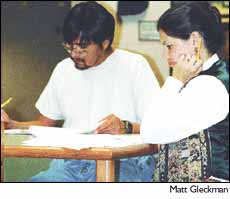March 2, 2000
By Matt Gleckman Parents, teachers and administrators met last Tuesday night to attempt the controversial Colorado Student Assessment Program (CSAP) test, and some questions were answered, but more were raised. "I thought that the test was pretty tough, but if the teachers can use it as a guideline for what they teach, then I think the kids would be in pretty good shape," said Merlene Lanier, a local parent. The CSAP is a standardized test intended to evaluate individual students’ proficiency in reading, writing, math and science at the middle school and high school levels. Last fall, Gov. Bill Owens declared an "educational emergency" following the release of the CSAP test scores. According to the scores, only 59 percent of Colorado fourth graders were reading at or above the state’s acceptable level. Organized by Channel 9 News and The Denver Post, "Take the Test Week" was intended to give non-students across Colorado a better understanding of what middle school children should know in order to be considered "proficient" by the state, as well as to give them an overview of the CSAP test. At the local level, "Take the Test Night" was organized by the middle school’s accountability organization — a group of parents and teachers who meet monthly to discuss building level education issues. Approximately 20 adults filed into the Cortez Middle School Library to try their hand at the test, and by the end opinions were varied. "I didn’t have enough time to finish the test," said Lanier, who was not alone in her timing woes. Of the 20 people who took the test, only three completed it. Although the allotted time for the adults was not proportional to the amount of time that students receive, this problem did raise the question of whether or not students get enough time to finish the test. Vic Bruce, Re-1 assistant superintendent, said that time restraints are usually not a problem with the CSAP. "The teachers who are administering the test are allowed to add an additional 10 minutes to the test time if they see that students are still working," said Bruce. "After that, any additional time gets added to the student’s adjustment." Special education students receive unlimited time on the test. However, according to special education/gifted and talented teacher, Judy Aeschlimann, the special ed students are not allowed to use the necessary tools (calculators, word processors, etc.) that they are used to. "These students have necessary aids, such as calculators, built into their special education plan and it really puts them at a disadvantage if they are not allowed to use this stuff," Aeschlimann said. "For most of the test, students aren’t even allowed to make a rough draft," she said. Other parents questioned whether or not the test is developmentally proper. "In the past, children listened to the radio and read books, and in order to do this, they had to be able to visualize the words," said Patsy Cone, a middle school parent. "Today, kids have TV, movies and video games — they have all the pictures given to them." "It also seems like you have to be able to do a lot of abstract thinking in order to do well on this test. I don’t know if we are asking fourth graders to do something that is developmentally impossible," she added. Another concern voiced by the group was the availability of the CSAP test in languages other than English. "Right now, the only other language that the test is available in is Spanish," said Bruce. Cindy Smart, principal of Lewis/Arriola Elementary School, said that students whose first language is not English are clearly at a drawback. "Without a good language background, students couldn’t do very well," Smart said. "When we used to take tests, we just had to make a mark inside a little circle," said Max Coyote, a local parent. "With these tests, you have to be able to do a lot of writing," he said. On Wednesday, eighth graders across the state took the math and science portion of the CSAP test, and will continue to take it today. |
||||
Copyright © 2000 the Cortez Journal. All rights
reserved. |
